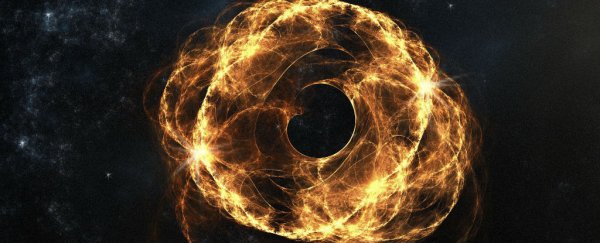Black holes are strange enough as it is, but new simulations point to the existence of a black hole in another universe that mimics the behaviour of a bizarre type of liquid that climbs walls and flows uphill.
This 'superfluid black hole' is the result of physicists modelling a theoretical black hole that behaves in a way that's mathematically identical to liquid helium when it enters a superfluid state, and they say it's so strange, our entire Universe probably couldn't support it.
"It's thinkable that these conditions could be satisfied in our Universe, but they're probably not," one of the team, Robert Mann from the University of Waterloo in Canada, told New Scientist.
If you're not familiar with the craziness of superfluids, don't worry, physicists are barely on top of it themselves.
A superfluid is an incredibly rare substance that has zero viscosity, which means it can flow without any loss of kinetic energy.
This property alone, thought to be a bizarre consequence of quantum mechanics, leads to all kinds of amazing behaviours, like the ability to flow 'upwards' against gravity, or fit into spaces that are mere molecules wide.
And here's why scientists particularly like superfluids - they can conduct electricity with no resistance.
As J. R. Minkel writes for Scientific American, we've known for decades that if you cool liquid helium to a few degrees below its boiling point of –269°C (–452°F), it will transition into a superfluid state.
"[I]t will suddenly be able to do things that other fluids can't, like dribble through molecule-thin cracks, climb up and over the sides of a dish, and remain motionless when its container is spun," says Minkel.
It even does the opposite of remaining motionless in a moving container - if you get it spinning in a motionless container, it will stay that way… forever.
"If you set [down] a cup with a liquid circulating around, and you come back 10 minutes later, of course it's stopped moving," physicist John Beamish from the University of Alberta, Canada, told Minkel.
"But if you did that with helium at low temperature, and came back a million years later, it would still be moving."
Superfluids have been very difficult to identify in nature, but we do know it occurs in two isotopes of helium (helium-3 and helium-4) when they're liquified by cooling to cryogenic temperatures, and physicists think they could exist elsewhere in astrophysics, high-energy physics, and theories of quantum gravity.
Now, Mann and his team have observed the same kind of behaviour when they simulated a specific type of black hole - called an anti-de Sitter black hole - under the conditions of Lovelock gravity.
Also known as the Lovelock theory of gravity, this state is a hypothetical generalisation of Einstein's theory of general relativity, so that in three and four dimensions, it coincides with Einstein's theory, but in higher dimensions - such as the fifth, sixth, and seventh dimensions - the laws of physics differ.
Such a state has not been seen in our own Universe, but physicists suggest that it could govern the laws of physics in other universes, and strangely enough, when you stick a model black hole in a universe with Lovelock gravity, you get the mathematical equivalent of a superfluid.
"These model black holes are exotic, existing in a higher-dimensional space-time with properties very different from our own," Leah Crane explains for New Scientist.
"Given certain conditions for gravity's interaction with matter, the switch to superfluidity could potentially happen in a wider set of black holes - but probably not ones in our Universe."
So why is it important? Well, unfortunately, the research isn't going to help us find a superfluid black hole IRL, because we're not even sure that other universes even exist, let alone if they contain even more bizarre black holes than the ones we've got.
But the discovery does give physicists a unique opportunity to explore the properties of superfluids without needing to produce some in a liquid helium sample, and that could lead to new ways of manipulating them for zero-resistance energy.
The simulation also works in the opposite way - for the first time, it allows scientists to use superfluids to figure out how black holes in our own Universe might behave under certain conditions.
As physicist Jennie Traschen from the University of Massachusetts Amherst, who wasn't involved in the study, tells Crane, "This could tell us something about superfluids which we can't calculate by other methods, so that's part of the excitement."
And we just love it when two of the most bizarre phenomena in the Universe come together so perfectly, so we can get a better insight into both.
Thank you, weird physics.
And now let's all appreciate this helium superfluid leaking through glass and climbing out of its container:
The study has been published in Physical Review Letters.
